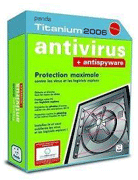Panda Antivirus 2006
Installation:
Allows for custom installation options if you want, but most of the options default to the safe side. We used the custom install so we could disable the Firewall (for testing purposes). The product also offers Web Content Filtering that defaults to not installed. The only default you may want to change is the “Collaborative Agreement” which, like several security companies on the market, offers to report attack and virus information to its headquarters. It does explain clearly the information will be anonymous, although this doesn’t change our opinion of turning it off. The install concludes with asking you to register followed by a reboot. No application or virus updating is performed during the installation.
Configuration:
The virus definition updates are done automatically and quickly after installation reboot. After the update the application asks you to reboot your computer again to make updates effective. We learned during the first reboot, to remove the Panda Titanium CD from the drive if you have it set as a boot option, as it doubles as Safe Recovery CD for virus scanning. The Control Panel is user friendly and allows you to do things like setup an administrator password, enable Heuristic scanning, and much more. The one recommendation we would make is to setup a scheduled full system scan as the application doesn’t automatically do this.
Resources:
A very neat feature in Panda is the ability to use the ‘CPU Load Management’ option to manage how much CPU resources are used during a system scan. Panda is the only product we’ve found this feature in. Panda had an extremely fast scanning engine that finished scanning our 4gig drive in a record time of only six minutes. Although, it does have many background system processes it runs using a lot of system resources. This might be due to Panda Titanium being a ‘Security Suite’ and more than just an antivirus solution. It also costs 156mb of hard drive space.
APVXDWIN.EXE 10.3
AVENGINE.EXE 43
IFACE.EXE 7
PAVFNSVR.EXE 10.3
PAVJOBS.EXE 26.5
PAVPRSRV.EXE 1.7
PAVSRVS1.EXE 9
PSIMSVC.EXE 3.3
PSKMSSVC.EXE 11.4
TPSRV.EXE 23.8
WEBPROXY.EXE 1.2
Ability:
Surprisingly, it did not stop any viruses from landing on the hard drive, and seemed as though it wasn’t running a real-time protection at all. We verified the control panel settings and made sure the product was up to date.
|
Real-Time |
Full Scan |
| AOL Trojan |
NO |
YES |
| Backdoor – Ambush |
NO |
YES |
| DOS-Misoska |
NO |
YES |
| Email-LoveLetter |
NO |
YES |
| Exploit-GetAdmin |
NO |
YES |
| IM Worm-Jitux |
NO |
YES |
| MSOfficeVirus-Darkstar |
NO |
YES |
| Nuke-Genocide |
NO |
YES |
| Trojan-FakeGina |
NO |
YES |
| Worm-Doomjuice |
NO |
YES |
(Real-Time: This is the preferred detection method. The virus was stopped as it entered the computer, before it planted itself onto any media such as the hard drive. Full Scan: The virus planted itself onto the media of the computer such as a folder on the hard drive and was found during a scheduled Full Scan. NA means the Full Scan was not needed.)
Uninstall Notes:
A reboot concludes uninstalling the product. Our system with left with a Panda directory structure, taking up less than 1mb, and we were unable to delete the signature files that were left.
Support:
Support requires you to go through the online knowledgebase tool, and if you require more support a technical support form is provided. We could find no phone number for support.
Price & Options:
We tested Panda Titanium, which will cost you $79.95 for the year. At the time of the review, they didn’t offer a strict antivirus solution.
|
|
| Ability: |
|
| Install/Config: |
|
| Price: |
|
| Resources: |
|
| Support: |
|

